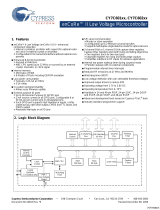
UM10116_3 © NXP B.V. 2009. All rights reserved.
User manual Rev. 03 — 10 February 2009 6 of 149
NXP Semiconductors
UM10116
P89LPC933/934/935/936 User manual
P0.2/CIN2A/
KBI2/AD11
25 21 I/O P0.2 — Port 0 bit 2.
I CIN2A — Comparator 2 positive input A.
I KBI2 — Keyboard input 2.
I AD11 — ADC1 channel 1 analog input.
P0.3/CIN1B/
KBI3/AD12
24 20 I/O P0.3 — Port 0 bit 3.
I CIN1B — Comparator 1 positive input B.
I KBI3 — Keyboard input 3.
I AD12 — ADC1 channel 2 analog input.
P0.4/CIN1A/
KBI4/DAC1
23 19 I/O P0.4 — Port 0 bit 4.
I CIN1A — Comparator 1 positive input A.
I KBI4 — Keyboard input 4.
O DAC1 — Digital-to-analog converter output 1.
I AD13 — ADC1 channel 3 analog input.
P0.5/
CMPREF/
KBI5
22 18 I/O P0.5 — Port 0 bit 5.
I CMPREF — Comparator reference (negative) input.
I KBI5 — Keyboard input 5.
P0.6/CMP1/
KBI6
20 16 I/O P0.6 — Port 0 bit 6.
O CMP1 — Comparator 1 output.
I KBI6 — Keyboard input 6.
P0.7/T1/
KBI7
19 15 I/O P0.7 — Port 0 bit 7.
I/O T1 — Timer/counter 1 external count input or overflow output.
I KBI7 — Keyboard input 7.
P1.0 to P1.7 I/O, I
[1]
Port 1: Port 1 is an 8-bit I/O port with a user-configurable output type,
except for three pins as noted below. During reset Port 1 latches are
configured in the input only mode with the internal pull-up disabled. The
operation of the configurable Port 1 pins as inputs and outputs depends
upon the port configuration selected. Each of the configurable port pins
are programmed independently. Refer to Section 5.1
for details. P1.2 and
P1.3 are open drain when used as outputs. P1.5 is input only.
All pins have Schmitt trigger inputs.
Port 1 also provides various special functions as described below:
P1.0/TXD 18 14 I/O P1.0 — Port 1 bit 0.
O TXD — Transmitter output for the serial port.
P1.1/RXD 17 13 I/O P1.1 — Port 1 bit 1.
I RXD — Receiver input for the serial port.
P1.2/T0/SCL 12 8 I/O P1.2 — Port 1 bit 2 (open-drain when used as output).
I/O T0 — Timer/counter 0 external count input or overflow output (open-drain
when used as output).
I/O SCL — I
2
C serial clock input/output.
Table 2. Pin description
…continued
Symbol Pin Type Description
TSSOP28,
PLCC28
HVQFN28





















